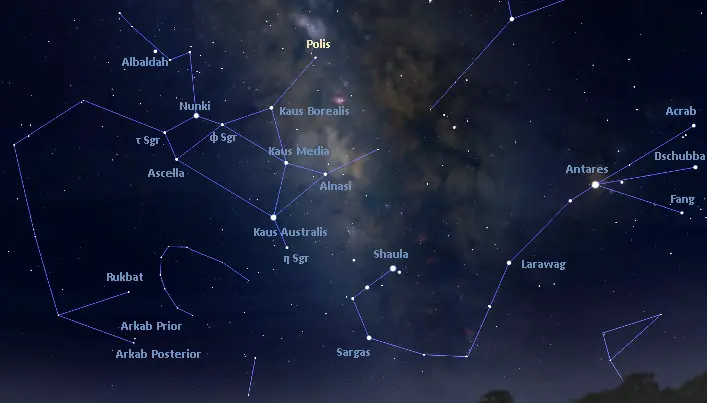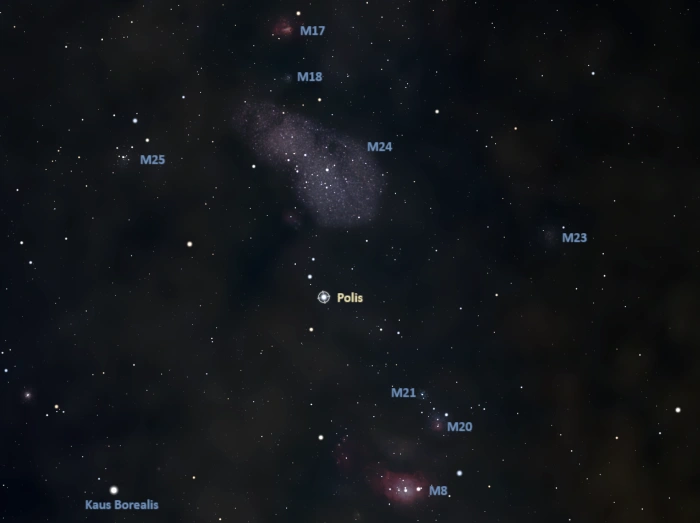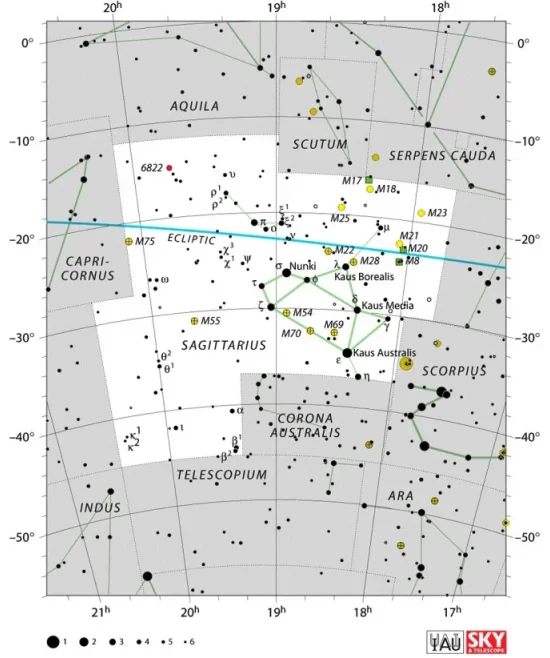Polis, Mu Sagittarii (μ Sgr), is a multiple star system located approximately 5,100 light-years away in the constellation Sagittarius. With a combined apparent magnitude of 3.85, it is the 13th brightest star in the constellation. It appears just north of the Teapot, a prominent asterism formed by the Archer’s brightest stars.
Star system
Mu Sagittarii is a multiple star system consisting of components designated Mu Sagittarii A through E. The component Mu Sagittarii A is itself a spectroscopic binary star composed of Mu Sagittarii Aa and Mu Sagittarii Ab.
Mu Sagittarii A is a massive double star composed of a hot blue supergiant, Mu Sagittarii Aa, with the stellar classification B8Iap and a massive hot blue companion of the spectral type B2III, B1.5V or B9III, indicating a main sequence star or a giant.
Formally known as Polis, Mu Sagittarii Aa has 23 times the Sun’s mass and a radius of 115 solar radii. This makes the star larger than the orbit of Mercury and comparable to the orbit of Earth in the solar system. With a surface temperature of 12,200 K, the supergiant is 180,000 times more luminous than the Sun.
The close companion, Mu Sagittarii Ab, has an estimated mass between 9.8 and 15 solar masses and a radius of 12.2 solar radii. The star is hotter than its spectroscopic companion, with an effective temperature of 23,000 K. It has an estimated age of only 10 million years.
Both components of Mu Sagittarii A are supernova candidates. The two stars have an orbital period of 181 days.
The Mu Sagittarii A system is classified as an Algol-type eclipsing binary star. Algol variables are binary stars that eclipse each other as they orbit around a common centre of mass. The eclipses cause the brightness of these systems to decrease at regular intervals. The brightness of Mu Sgr A has been observed to decrease by 0.08 magnitudes, from magnitude 3.84 to 3.96.

Polis (Mu Sagittarii), image credit: ESO/Digitized Sky Survey 2 (CC BY 4.0)
Other relatively bright Algol variables include the class prototype Algol in the constellation Perseus, Almaaz in Auriga, Mintaka in Orion, Alsephina in Vela, Alphecca in Corona Borealis, Lambda Tauri in Taurus, and Wurren in Phoenix.
Polis, the primary component of Mu Sgr A, is also classified as an Alpha Cygni variable. Like Deneb (Alpha Cygni) in the northern constellation Cygnus (the Swan), the star is an irregularly pulsating supergiant. Alpha Cygni variables exhibit non-radial pulsations, which is to say that some parts of their surface are contracting while others expand at the same time. The pulsations cause variations in brightness on the order of 0.1 magnitudes over seemingly irregular periods.
Other bright Alpha Cygni variables include Rigel and Alnilam in the constellation Orion, Aludra and Omicron2 Canis Majoris in Canis Major, Shaomin in Leo, and Kappa Cassiopeiae in Cassiopeia.
The components Mu Sgr B through E are designated in order of their separation from the primary component. They are believed to be either only weakly bound to Polis or not physically bound to it at all. The properties of the companions are uncertain.
Mu Sagittarii B lies 16.9 arcseconds from Mu Sgr A, corresponding to a minimum physical distance of 42,200 astronomical units (0.67 light-years). The star has an apparent magnitude of 8.04. It is a hot blue giant with the spectral type B9III. It has an effective temperature of 18,200 K and shines with 603 solar luminosities.
Mu Sagittarii C is considered to be only an optical companion to the Polis system. It has an apparent magnitude of 10.99, well below unaided eye visibility, and is separated by 25.8 arcseconds from the primary component. The star lies at a minimum distance of 64,500 AU (1.02 ly) from Polis and is believed to be a foreground star. It has the spectral classification A3V, indicating a white main sequence star slightly hotter and more massive than the Sun.
Mu Sagittarii D shines at magnitude 9.63 and appears at a separation of 48.5 arcseconds from the primary. This corresponds to a physical distance of at least 121,200 AU, or 1.92 ly. The star is a blue subgiant of the spectral type B2IV. It has a mass of 5.940 solar masses and a radius 4.95 times that of the Sun. It is 1,764 times more luminous than the Sun and has an effective temperature of around 16,487 K.
Mu Sagittarii E appears at a separation of 50 arcseconds from Mu Sgr A, corresponding to a physical separation of at least 125,000 AU (1.98 ly). The star has an apparent magnitude of 9.25. It is classified as a hot blue main sequence star of spectral type B2.5V. It has a mass of around 6.47 solar masses and a radius of 6.36 solar radii. With a surface temperature of 16,700 K, it is 2,668 times more luminous than the Sun.
Facts
The Mu Sagittarii star system is part of the Sagittarius OB1 association. The primary component was discovered to be a single-lined spectroscopic binary star by Foster and Adams in 1904.
The variability of Mu Sagittarii A was reported by Morgan and Elvey in 1938. The astronomers observed a decline in brightness by about 0.14 magnitudes, lasting about 20 days, in May 1938.
In Arabic astronomy, Polis and Kaus Borealis were known as Ra’i al Na’aim, “the keepers of the ostriches.” They were seen as keepers of two groups of ostriches, the going ostriches (Al Naʽāma al Wārida) and the returning ostriches (Al Naʽām al Ṣādirah). The ostriches going down to the water (represented by the Milky Way) to drink were represented by the stars Kaus Media, Kaus Australis, Alnasl and Eta Sagittarii, and the returning ostriches by Nunki, Ascella, Phi Sagittarii, Chi Sagittarii, and Tau Sagittarii.
Name
The name Polis (pronunciation: /ˈpɒlɪs/) is Greek for “city.” It was the name of the ancient lunar station that contained Mu Sagittarii. The lunar station, named πολις (polis), was listed in a Coptic manuscript of lunar stations, believed to be of Greek origin. The Copts saw the stars of the Archer’s bow as Polis, a foal.
The International Astronomical Union’s (IAU) Working Group on Star Names (WGSN) approved the name Polis on September 5, 2017. The name formally applies only to the primary component, Mu Sagittarii Aa, but is informally used for the whole star system.
In old Chinese astronomy, Polis was known as 斗宿三 (Dǒu Sù sān), the Third Star of Dipper. It formed the Dipper asterism with Phi Sagittarii, Kaus Borealis (Lambda Sagittarii), Nunki (Sigma Sagittarii), Tau Sagittarii, and Ascella (Zeta Sagittarii). The asterism was part of the Black Tortoise, one of the Four Symbols of the traditional Chinese constellations.
Location
Polis is relatively easy to find because it appears just above the Teapot, an asterism formed by the brightest stars in Sagittarius. It can be found by extending a line from Kaus Australis (Epsilon Sagittarii) through Kaus Media (Delta Sagittarii), or from Ascella (Zeta Sagittarii) through Phi Sagittarii.
Polis appears in the same region of the sky as several bright deep sky objects. These include the open clusters Messier 21 (Webb’s Cross), Messier 23 and Messier 25, the Small Sagittarius Star Cloud (Messier 24), and the nebulae Messier 8 (the Lagoon Nebula) and Messier 20 (the Trifid Nebula). These objects can be found using the stars of the Teapot.

Location of Polis (Mu Sagittarii), image: Stellarium

Deep sky objects near Polis, image: Stellarium
Constellation
Polis is located in the constellation of Sagittarius. The celestial Archer is one of the Greek constellations, catalogued by Claudius Ptolemy of Alexandria in his Almagest in the 2nd century CE. In Greek mythology, the constellation is identified as a centaur or as the satyr Crotus. The Archer is usually depicted aiming an arrow at Antares, the star that marks the heart of the Scorpion.
Sagittarius occupies an area of 867 square degrees of the southern sky and is the 15th largest of the 88 constellations. Even though it does not contain any first magnitude stars, it is one of the easiest constellations to identify. Its eight bright stars form the Teapot, a conspicuous asterism located next to the Milky Way’s bright band.
Kaus Australis (Epsilon Sagittarii), the brightest star in Sagittarius, is a hot blue subgiant star that shines at magnitude 1.85 from a distance of 143 light-years. It forms the Archer’s bow with the orange giants Kaus Media (Delta Sagittarii) and Kaus Borealis (Lambda Sagittarii).
Other relatively bright stars in Sagittarius include the hot blue main sequence stars Nunki (Sigma Sagittarii), Arkab Prior (Beta1 Sagittarii) and Rukbat (Alpha Sagittarii), the triple star systems Zeta Sagittarii (Ascella) and Nu1 Sagittarii (Ainalrami), the orange giants Alnasl (Gamma2 Sagittarii) and Tau Sagittarii, the red giant Eta Sagittarii, the F-type star Arkab Posterior (Beta2 Sagittarii), and the white subgiant Albaldah (Pi Sagittarii).
Sagittarius also hosts the Wolf Rayet star WR 102ka, popularly known as the Peony Star, and the luminous blue variable nicknamed the Pistol Star. Both are among the most luminous stars discovered in our galaxy to date. The red supergiants VX Sagittarii and KW Sagittarii are among the largest known stars. The constellation is also home to the Wolf-Rayet star WR 104 (the Pinwheel Star), the nearby red dwarf Ross 154 and the born-again star V4334 Sagittarii (Sakurai’s Object).

Sagittarius constellation map by IAU and Sky&Telescope magazine (Roger Sinnott & Rick Fienberg) (CC BY 3.0)
Bright deep sky objects in Sagittarius include the globular clusters Messier 28, Messier 54, Messier 55, Messier 70 and Messier 75, the Small Sagittarius Star Cloud (Messier 24), the open clusters Messier 18, Messier 23, Messier 25, and the nebulae Messier 8 (the Lagoon Nebula), Messier 17 (the Omega Nebula) and Messier 20 (the Trifid Nebula).
Sagittarius also contains Sagittarius A*, the black hole at the centre of our Milky Way galaxy, the massive open clusters known as the Arches Cluster and the Quintuplet Cluster near the Milky Way’s centre, Barnard’s Galaxy (NGC 6822, Caldwell 57), the Sagittarius Dwarf Elliptical Galaxy, the globular clusters NGC 6723 and NGC 6544, and the planetary nebulae NGC 6565, NGC 6578, the Little Gem Nebula (NGC 6818), the Box Nebula (NGC 6445), the Eye of Sauron Nebula (M1-42), and the Red Spider Nebula (NGC 6537).
The best time of the year to observe the stars and deep sky objects in Sagittarius is during the month of August, when the constellation climbs higher above the horizon in the early evening. The entire constellation is visible from locations south of the latitude 55° N.
The 10 brightest stars in Sagittarius are Kaus Australis (Epsilon Sgr, mag. 1.85), Nunki (Sigma Sgr, mag. 2.05), Ascella (Zeta Sgr, mag. 2.59), Kaus Media (Delta Sgr, mag. 2.70), Kaus Borealis (Lambda Sgr, mag. 2.82), Albaldah (Pi Sgr, mag. 2.89), Alnasl (Gamma² Sgr, mag. 2.98), Eta Sagittarii (mag. 3.11), Phi Sagittarii (mag. 3.17), and Tau Sagittarii (mag. 3.326).
Polis – Mu Sagittarii
| Apparent magnitude | 3.85 |
| Distance | 5,100 ± 300 light-years (1,550 ± 90 parsecs) |
| Parallax | 0.6437 ± 0.038 mas |
| Radial velocity | -6.0 km/s |
| Proper motion (Mu Sgr AB) | RA: 0.30 ± 0.30 mas/yr |
| Dec.: -0.48 ± 0.19 mas/yr | |
| Constellation | Sagittarius |
| Right ascension | 18h 13m 45.8088401s |
| Declination | −21° 03′ 31.794073″ |
| Names and designations | Polis, Mu Sagittarii, Mu Sgr, μ Sagittarii, μ Sgr, 13 Sagittarii, 13 Sgr, SAO 186497, ADS 11169, CCDM J18210-2950, IDS 18078-2105, WDS J18138-2104 |
Mu Sagittarii A
| Spectral class | B8Iap + B1.5 V |
| Variable type | Algol variable + Alpha Cygni variable |
| U-B colour index | -0.52 |
| B-V colour index | +0.22 |
| Apparent magnitude | 3.88 |
| Absolute magnitude | -7.1 |
| Names and designations | Mu Sagittarii A, Mu Sgr A, μ Sagittarii A, μ Sgr A, 13 Sagittarii A, 13 Sgr A, HD 166937, HR 6812, HIP 89341, SAO 186497, FK5 682, PPM 268080, BD−21°4908, SKY# 33184, GC 24856, GCRV 10672, ALS 4791, PLX 4178.00, PMC 90-93 486, CSI-21 4908 1, SBC7 667, SBC9 1033, SACS 397, SRS 30682, ROT 2572, GEN# +1.00166937A, GEN# +1.00314059A, GSC 06276-03093, EM* MWC 598, MCW 629, LS 4791, JP11 2948, N30 4047, IRAS 18107-2104, 2MASS J18134581-2103319, TD1 21905, TIC 117866844, [SC96] Mis 1153, [SC96] GC 491, [B10] 4604, UBV 21651, UBV M 22737, UCAC4 345-134083, WEB 15190, YZ 111 7550, TYC 6276-3093-1, Gaia DR2 4093933487667449984, Gaia DR3 4093933487636355968, CCDM J18138-2104A, IDS 18078-2105 A, WDS J18138-2104A |
Mu Sagittarii Aa
| Mass | 23 M☉ |
| Luminosity | 180,000 L☉ |
| Radius | 115 R☉ |
| Temperature | 12,200 K |
| Surface gravity | 1.75 cgs |
Mu Sagittarii Ab
| Mass | 9.8 – 15 M☉ |
| Radius | 12.2 R☉ |
| Temperature | 23,000 K |
| Age | 10 million years |
| Surface gravity | 4.0 cgs |
Mu Sagittarii B
| Spectral class | B9III |
| U-B colour index | -0.11 |
| B-V colour index | +0.04 |
| Apparent magnitude | 8.04 |
| Absolute magnitude | -1.2 |
| Luminosity | 603 L☉ |
| Temperature | 18,200 K |
| Names and designations | Mu Sagittarii B, Mu Sgr B, μ Sagittarii B, μ Sgr B, 13 Sagittarii B, 13 Sgr B, HD 166937B, BD-21 4908B, CSI-21 4908 2, LS 4790, ALS 4790, DENIS J181344.6-210335, GEN# +1.00166937B, 2MASS J18134463-2103353, TIC 117866835, Gaia DR2 4093933487627510528, Gaia DR3 4093933487675888768, ADS 11169 B, CCDM J18138-2104B, WDS J18138-2104B |
Mu Sagittarii C
| Spectral class | A3V |
| U-B colour index | -0.30 |
| B-V colour index | +0.23 |
| Apparent magnitude | 10.99 |
| Names and designations | Mu Sagittarii C, Mu Sgr C, μ Sagittarii C, μ Sgr C, 13 Sagittarii C, 13 Sgr C, HD 166937C, BD-21 4908C, CSI-21 4908 3, Renson 46974, 2MASS J18134445-2103384, TIC 117866820, GEN# +1.00166937C, BU 292C, ADS 11169 C, CCDM J18138-2104C, IDS 18078-2105 C, WDS J18138-2104C |
Mu Sagittarii D
| Spectral class | B2IV |
| U-B colour index | -0.57 |
| B-V colour index | +0.23 |
| Apparent magnitude | 9.63 |
| Absolute magnitude | -3.3 |
| Mass | 5.940 M☉ (5.712 – 6.209 M☉) |
| Luminosity | 1,764 L☉ (1,494 – 2,162 L☉) |
| Radius | 4.95 R☉ (4.5 – 5.25 R☉) |
| Temperature | 16,487 K (16,287 – 16,759 K) |
| Surface gravity | 3.82 cgs (3.77 – 3.89 cgs) |
| Names and designations | Mu Sagittarii D, Mu Sgr D, μ Sagittarii D, μ Sgr D, 13 Sagittarii D, 13 Sgr D, HD 314058, HD 314059, BD−21°4907, AP J18134321-2102595, GSC 06276-01838, GEN# +1.00166937D, TIC 117866933, UCAC4 345-134025, YZ 111 7549, 2MASS J18134321-2102595, TYC 6276-1838-1, Gaia DR2 4093934243581713152, Gaia DR3 4093934243590140800, HJ 2822D, ADS 11169 D, CCDM J18138-2104D, IDS 18078-2105 D, WDS J18138-2104D |
Mu Sagittarii E
| Spectral class | B2.5V |
| U-B colour index | -0.67 |
| B-V colour index | +0.04 |
| Apparent magnitude | 9.25 |
| Absolute magnitude | -2.1 |
| Mass | 6.47 ± 0.21 M☉ |
| Luminosity | 2,668 L☉ (2,370 – 3,005 L☉) |
| Radius | 6.36 R☉ (6.05 – 6.72 R☉) |
| Temperature | 16,700 K (16,400 – 16,900 K) |
| Surface gravity | 3.55 ± 0.03 cgs |
| Names and designations | Mu Sagittarii E, Mu Sgr E, μ Sagittarii E, μ Sgr E, 13 Sagittarii E, 13 Sgr E, HD 314057, BD−21°4909, BD-21 4908E, CSI-21 4908 4, GSC 06276-01101, DENIS J181349.0-210353, 2MASS J18134906-2103528, GEN# +1.00166937E, UCAC2 23447851, TIC 117866771, TYC 6276-1101-1, Gaia DR2 4093933448976732160, Gaia DR3 4093933448976732160, HJ 2822E, ADS 11169 E, CCDM J18138-2104E, WDS J18138-2104E |